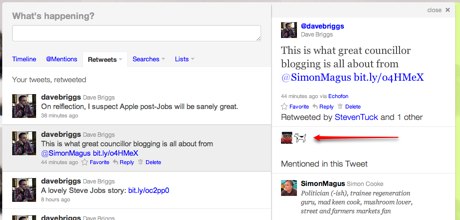A quick plug of this great workshop being delivered through the Public Sector Web Network (about which I will shortly have some very exciting news!).
Social Media for Emergency Planning & Resilience
Thursday 22nd September 2011, Park Plaza Hotel, Leeds
This workshop is aimed at all Category 1 Responders as identified in the Civil Contingencies Act 2004 which includes the usual “blue-light” emergency services as well as others:
- Police forces, including the British Transport Police
- Fire services
- Emergency medical services in the United Kingdom
- HM Coastguard
- Local authorities
- Port Health Authorities
- Primary Care Trusts, Acute Trusts, Foundation Trusts (and Welsh equivalents), Health Protection Agency
- Environment Agency and the Scottish Environment Protection Agency
A category one responder or other organisation planning for major incidents should:
- have the capacity to process between 3,000-20,000 items of social media traffic per day during the response phase of an emergency *routinely monitor social media for operational data and potentially for triggers for emergency response
- understand the potential of the global online community in emergency response
- understand the implications of online culture in managing an emergency.
This workshop will help attendees to not only maximise the benefit of situational intelligence but also manage social media flows robustly and warn and inform the public effectively.
Please contact Nick Hill at nick@publicsectorforums.co.uk to reserve a delegate place!
Workshop Facilitator: Ben Proctor
Ben has a background in Public Relations, Information Technology and Emergency Planning. In 2008 he saw that emergency response and crisis communications were going to be strongly affected by developments in mobile and online technology so he set up Likeaword to become a centre of expertise in digital skills for emergencies. Ben is based in Shropshire, UK but works across the country with category one responders and other organisations looking to manage their response to emergencies. He works with emergency planning and business continuity professionals as well as with corporate communication specialists.
Agenda
1 Welcome and introduction
2 Check we’re all on the same page
- quick summary of civil contingency arrangements, the roles and responsibilities of responders and individuals within responders
- quick round up of social media, related online technology, and relevant mobile technology
- introduce an emergency scenarios to be explored during the day as a desktop exercise
3 Use of social media for warning and informing the public
Social media offers responders a simple, low cost broadcast medium and many responders have begun to use it in this way
- case studies of effective uses of the technology
- discussion on strengths and weaknesses of the technology and the risks inherent in its use including discussion of the implications of power and telecoms failure
- discussion on how social media for warning and informing can be integrated into emergency plans
- run desktop exercise to examine how social media for warning and informing could be introduced into management
Lunch
4 Managing feedback in the social media space
Social media allows all individuals and organisations access to the same simple, low-cost broadcast medium. Individuals may ask for clarification, they may challenge or may spread rumours or contrary information.
- case studies of effective uses of the technology
- discussion on strengths, weaknesses and risks of various approaches (passive, reactive, proactive)
- discussion on integration into emergency plans
- discussion on the training and exercising implications of effective management of feedback
- re-run desktop exercise with new injects to model social media feedback
5 Working with the online community
Social media and online technology gives responders potential access to a worldwide community of relevant skills. This section will introduce the topic.
- case studies and examples of interesting and effective community engagement in emergencies (and independet community response)
- discussion on the implications for responders
6 Wrap up
- re-cap over the day’s learning
- opportunity to cover points that may have been missed
- some suggestions for further reading and discussion
Address:
Park Plaza Hotel
Boar Lane, City Square
Leeds
LS1 5NS
Map and Directions
Start Time: 9:30 am
End Time: 4:30 pm
Price: £200.00 + £40.00 Surcharge
Please contact Nick Hill at nick@publicsectorforums.co.uk to reserve a delegate place!


